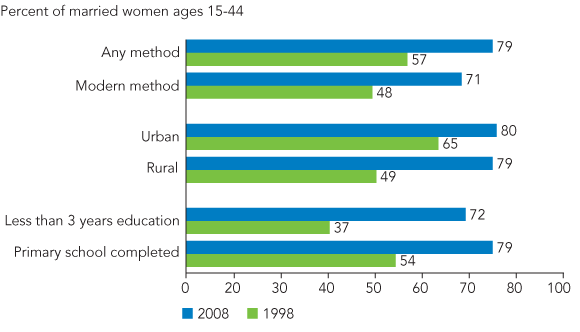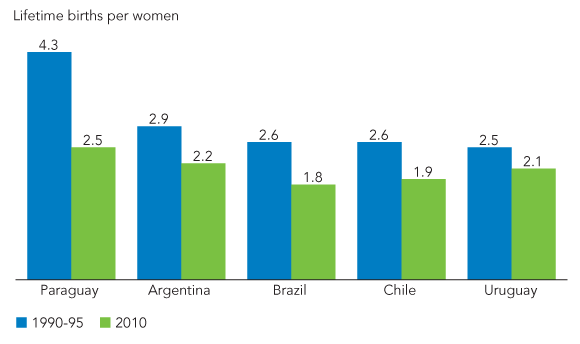
South American Transition to Low Fertility Spreads to Paraguay
Date
April 30, 2010
Author
(April 2010) Paraguay does not seem a likely candidate for rapid fertility decline: The population is poorer, more rural, and has lower educational levels than its neighboring countries. A large percentage of the population speaks Guarani, an indigenous language, rather than Spanish, the official language. Yet despite a large population that is traditionally hard to reach with reproductive health information and services, Paraguay recorded a remarkable increase in contraceptive use and a sharp decline in fertility over the past decade. A recent study of Paraguay’s fertility transition through 2004 documented a fall in the total fertility rate (TFR), or lifetime number of births per woman, from 4.3 in 1998 to 2.9 in the 2001-2004 period, and suggested continued decline because younger women said they wanted fewer children.1 A new survey seems to confirm that assertion, showing the TFR down to 2.5 children per woman by 2008, a faster decline than projected in the most recent United Nations’ population projection series.2 The percentage of married women ages 15 to 44 using contraception increased impressively, from 57 percent to 79 percent between 1998 and 2008.
There is a wide gap in TFRs between the more modern and educated populations and the more traditional population groups. The TFR was down to 2.2 children per woman among urban residents, while it was still 3.0 among rural residents in 2002. Similarly, Spanish-speaking women averaged just 2.2 children, compared with 3.3 among Guarani-speaking Paraguayans. The most dramatic differences were by education: Women with less than five years of education averaged 3.6 children, while those with at least 12 years of education averaged just 2.0 children.
Like many developing countries, Paraguay has seen rapid improvements in the education of girls in recent decades. Enrollment in elementary school is nearly universal, and data from UNESCO show the percentage enrolled in secondary school rising from 59 percent to 68 percent between 1999 and 2002, the most recent year statistics are available. This is well below the regional average of 92 percent, but a marked improvement in just a few years.3
Recent increases in the education of women in Paraguay have been tied to greater contraceptive use up through 2004. However, the 2008 survey shows that acceptance of contraceptive use has spread among all education levels. Even among women with less than three years of formal education, 72 percent used a contraceptive in 2008, compared with just 36 percent in 1998 (see Figure 1). Just as telling, the gap in contraceptive use between urban and rural women disappeared by 2008. While there are still clear rural and education differences in actual childbearing, it seems likely that those differences will abate further in coming years.
Figure 1
Increasing Contraceptive Use Among Paraguayan Women, 1998 to 2008

Source: El Centro Paraguayo de Estudios de Población et al., Paraguay Reproductive Health Survey 2008, CD-ROM.
Low Fertility in the Southern Cone
With the low and declining fertility documented in these new surveys, Paraguay joins its more urbanized and prosperous neighbors in South America’s southern cone in forming a low-fertility zone.
Brazil saw impressive declines in fertility since the mid-1990s, from about 2.5 children per woman to 1.8 according to the National Institute for Geography and Statistics (IBGE)—possibly the lowest in South America. Brazil’s fertility decline has been attributed to a shift in preferences for fewer children that some analysts tie to popular nighttime soap operas, or telenovelas, that reinforced the positive image of small families.4 Effective contraceptives are widely available, with sterilization (male and female combined) the most common method.5
Argentina has had relatively low fertility—below 3 children per couple—for decades, but the TFR only recently dropped close to the replacement level of 2.1 children per women (see Figure 2). Fertility has tracked even lower in Uruguay and Chile. Uruguay’s TFR is now at the two-child level, according to official birth statistics. Chile’s fertility declined close to replacement level by 2000, and is now about 1.9. While we do not have recent surveys of contraceptive use from these other countries, there is evidence that contraceptives are widely available and accepted.
Figure 2
Fertility Decline in Southern Cone Countries, 1990-95 to 2010

Sources: UN Population Division, World Population Prospects: The 2008 Revision; UN Statistics Division, UN Demographic Yearbook, 2006; Ministério da Saúde e Centro Brasileiro de Análise e Planejamento, Pesquisa Nacional de Demographfia e Saúde da Criança e da Mulher, 2006; El Centro Paraguayo de Estudios de Población et al., Paraguay Reproductive Health Survey 2008, CD-ROM.
Fertility Higher in Other South American Countries
While fertility rates have fallen throughout South America, they have not fallen as far in the more northern countries, especially in Bolivia, Ecuador, and Peru. Bolivia has among the region’s highest fertility, with a TFR of 3.5 according to a 2008 Demographic and Health Survey. Bolivia, with its large indigenous, non-Spanish speaking population, has the characteristics of a high-fertility country: lower educational levels, high poverty levels, a large rural population, and low use of modern contraceptives. The UN Population Division and the Center for Latin American and Caribbean Demography (CELADE) project modest fertility decline in Bolivia in the next two decades.
Fertility is expected to fall more rapidly in more economically developed and more urban countries of South America, including Colombia and Venezuela. They are projected to join the southern cone countries with replacement level fertility over the next decade. The major uncertainty is how fast fertility will fall, especially in areas that have lagged behind in economic and social development. The surprisingly rapid fertility decline in Paraguay shows how quickly things can change when young couples embrace the idea of smaller families and actively limit the number of children they have.
Mary Mederios Kent is senior demographic editor at the Population Reference Bureau.
References
- Kanako Ishida, Paul Stupp, and Mercedes Melian, “Fertility Decline in Paraguay,” Studies in Family Planning 40, no. 3 (2009): 227-34.
- El Centro Paraguayo de Estudios de Población et al., “Paraguay Reproductive Health Survey, 2008,” CD-ROM (Atlanta: Centers for Disease Control and Prevention, 2009).
- UNESCO, Institute for Statistics Data Centre, accessed at http://stats.uis.unesco.org, on March 26, 2010. These figures are for the gross enrollment in secondary schools: the total number of secondary students of any age divided by the number of children of secondary-school age.
- Vilmar E. Faria and Joseph E. Potter, “Television, Telenovelas, and Fertility Change in Northeast Brazil,” in Dynamics of Values in Fertility Change, ed. Richard Leete (Oxford, England: Clarendon Press, 1999); and Eliana La Ferrara, Alberto Chong, and Suzanne Duryea, “Soap Operas and Fertility, Evidence From Brazil” (Inter-American Development Bank, 2008), accessed at www.iadb.org/res/files/WP-633updated.pdf,, on April 6, 2010.
- Ministério da Saúde e Centro Brasileiro de Análise e Planejamento, Pesquisa Nacional de Demografia e Saúde da Criança e da Mulher, 2006, accessed at http://bvsms.saude.gov.br/bvs/pnds/index.php,, on April 1, 2010.
